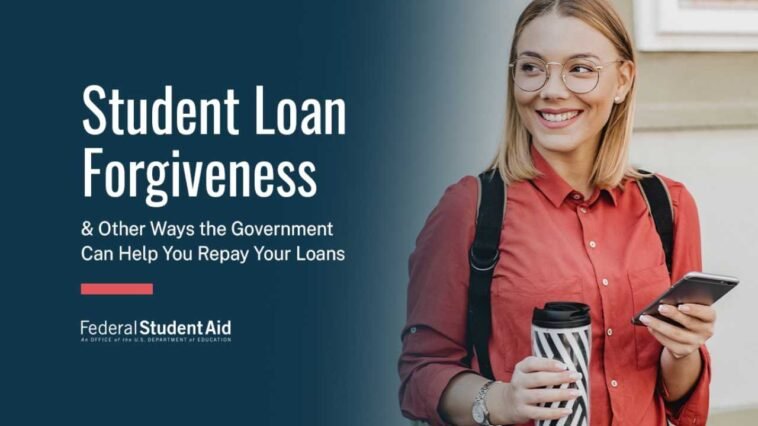Student loans are a big financial problem for many Americans, with total debt now over $1.7 trillion. For lots of people, paying back these loans can feel like a never-ending battle, leading to feelings of hopelessness and frustration. But there’s good news coming in 2025!
Recent updates about student loan forgiveness and new repayment plans could change how you handle your debt, making it easier and helping you move towards a debt-free life. In this easy-to-understand guide, we will explain the latest changes, show how they affect you, and give you practical tips to help you take full advantage of these programs.
Why Student Loan Forgiveness Matters
Student loans often limit what people can do with their money. They can make it harder to:
- Save for a home.
- Start a family or business.
- Build an emergency fund or retirement savings.
The Biden administration and federal programs are working to ease the financial strain of student loans by offering new repayment and forgiveness options. These updates provide borrowers a chance to save money and regain their financial stability.
Also Read: Best Personal Loan Rates 2025, Save Big with These Expert Tips
The Latest 2025 Student Loan Forgiveness Changes
1. SAVE Repayment Plan
The Saving on a Valuable Education (SAVE) plan is now the most affordable income-driven repayment plan.
- Lower Payments: Monthly payments are capped at just 5% of your discretionary income (down from 10% in older plans) for undergraduate loans.
- Faster Forgiveness: Remaining balances are forgiven after 10 years if your original loan was $12,000 or less.
- Interest Benefits: Unpaid interest is no longer added to your loan balance, so your debt won’t grow if your payments are small.
How to Apply:
- To manage your student loans effectively, log in to your account on StudentAid.gov, a user-friendly platform. Once logged in, navigate to the loan management section and update your repayment plan to fit your current financial situation and long-term goals, ensuring you make informed decisions that support your financial well-being.
2. Public Service Loan Forgiveness (PSLF)
If you work in public service (like teaching, healthcare, or government jobs), the PSLF program could cancel your remaining loan balance after 10 years of qualifying payments.
- Big Improvements: Big Improvements: Recent changes to the Public Service Loan Forgiveness (PSLF) program, especially under the Biden administration, have made it easier for borrowers to get their loans forgiven. This includes help for those who missed deadlines or made payments under the wrong plan, so they won’t be punished for these errors and can still achieve loan cancellation.
- Who Qualifies: Jobs in government agencies, including federal, state, and local roles, as well as positions in public schools like universities and community colleges, and most nonprofit organizations that help communities, are considered qualifying jobs for loan forgiveness and other benefits.
Action Tip: To ensure that you remain on track with your loan forgiveness and other benefits, it is essential to submit an Employment Certification Form every year, or whenever you change jobs, as this will help maintain your eligibility and keep your records up to date.
3. Income-Driven Repayment (IDR) Program Fixes
The administration is fixing past errors in tracking payments for Income-Driven Repayment (IDR) plans like Pay As You Earn (PAYE) and Income-Contingent Repayment (ICR).
- Retroactive Credits: Borrowers will get credit for more past payments, helping many move closer to forgiveness.
- Simpler Rules: IDR plans are easier to apply for and maintain than ever before.
Pro Tip: It is highly advisable to call your loan servicer directly to confirm and fully understand how these significant changes will impact your repayment timeline and overall loan management strategy.
How to Make the Most of These Changes
Getting loan forgiveness takes effort, but it’s worth it. Follow these steps to maximize your benefits:
- Review Your Loans
- To start your path to financial relief, visit StudentAid.gov, a helpful website, and check if your loans are federal or private. Remember, only federal loans can be forgiven through these programs, which can greatly reduce your financial stress.
- Understand Your Options
- Carefully evaluate different repayment plans, including the SAVE plan, the Public Service Loan Forgiveness (PSLF) program, and other Income-Driven Repayment (IDR) options, to find the one that best fits your income and financial goals.
- Keep Records
- It is very important to keep all documents carefully, like proof of payments, emails, and messages with loan servicers. This is essential because errors can occur, and having good records protects you. It ensures you have the right documents to back up your claims and fix any problems that might come up.
- Watch for Deadlines
- Programs like Public Service Loan Forgiveness (PSLF) and Saving on A Valuable Education (SAVE) need yearly updates to keep your eligibility for forgiveness. If you miss an important deadline, it can slow down the forgiveness process, making you pay back your loans longer and adding extra stress.
- Seek Help
- If you’re feeling stressed about managing your student loans, it’s a good idea to talk to a qualified student loan counselor or contact your loan servicer for help. These experts have the knowledge and tools to guide you through your options, find the best repayment plan for your financial situation, and help you avoid common mistakes that could cause more problems.
Alternatives if You Don’t Qualify
If you don’t meet the requirements for forgiveness programs, there are still options:
- Refinance Your Loans: You can lower your interest rate by refinancing your loans with a private lender. But be careful: if you refinance federal loans, you will lose access to important forgiveness programs that can help lower your debt.
- Employer Benefits: More companies are now offering student loan repayment assistance programs to help employees with their student debt. It’s a good idea to consult your HR department to find out what options and benefits you have.
- Scholarships for Existing Students: If you’re still in school, look for grants or scholarships that can help lower your future debt and support you financially during your education.
Looking Ahead: The Future of Student Loan Reforms
The Supreme Court’s recent choice to stop a bigger debt relief plan has slowed down some major forgiveness efforts that many were looking forward to. However, positive changes like the SAVE plan show real progress. Also, lawmakers are talking about new ways to lower rising tuition costs and improve financial aid options. Together, these efforts bring hope for a more affordable and accessible education system in the future.
Student loans don’t have to dictate your future. By learning about your choices and using programs like SAVE or PSLF, you can lower your monthly payments, protect your finances from heavy debt, and work towards a debt-free future that lets you follow your dreams without financial stress.
By taking smart steps and making good choices, you can create a financial situation that helps you instead of holding you back. This path to financial freedom is not just about handling debt; it’s about creating a life where you can succeed and pursue your goals without always worrying about money.
Visit StudentAid.gov today to check out your options and start your journey to financial freedom, where many opportunities await you, free from the burden of student debt.





GIPHY App Key not set. Please check settings